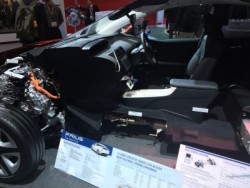Here is what you missed on thermal management at the 2016 SAE World Congress
- Honda showed how they doubled the power and halved their costs of the Thermo-Electric Generator module with some very clever packaging and design on the Civic. Most of us in this area know that moving the TEG module closer to the engine will generate more power as the exhaust gas is much hotter, but what stops us is the packaging. Honda shared a closely coupled Catalyst-TEG design which put the TEG in the underhood compartment immediately after the catalyst rather than under-floor installment. Additionally using a clever design they called “Heat concentration Structure”, (using electrodes), they were able to generate the same power by reducing the number of TE elements by 25%.
- Prof Paul Shayler presented a correlation between crank train oil gallery pressure and engine friction. His study claims that engine friction can be reduced by 14% at low loads by reducing the oil feed pressure to the main bearings and big end bearing from 3 bar to 1.5 bar, while keeping the feed to the turbocharger and valve train unchanged. One the key drivers of the reduction in engine friction was attributable to increased cavitation (acceptable levels?). They estimated a fuel consumption reduction of 1.64% over the NEDC cycle.
- Clemson University presented an interesting paper on reduction in power required to cool the engine on M-ATV Military vehicle. By using an electronic control valve, coolant pump and fan, they were able to reduce the cooling power required by 14%, while providing a finer control of the coolant temperature. I admit, this was a military vehicle, and I admit that the electrical pump and control valve are expensive, but with increasing mild hybridization in the roadmap for the car makers, this is definitely a good low hanging fruit for fuel economy improvement.
And finally, here is a nice little cut out of the New Toyota Prius with their EHRS system on display.


